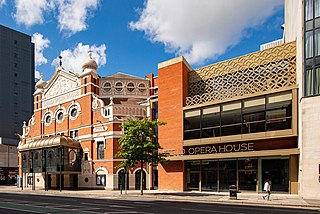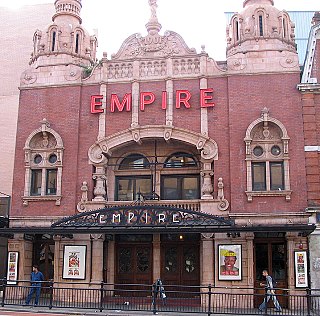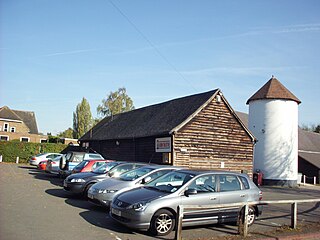
Mamma Mia! is a jukebox musical written by British playwright Catherine Johnson based on songs recorded by Swedish group ABBA and composed by members Benny Andersson and Björn Ulvaeus. The musical's title is taken from the group's 1975 chart-topper "Mamma Mia". Ulvaeus and Andersson were involved in the development of the show from the beginning, while singer Anni-Frid Lyngstad was involved financially in the production and also appeared at many of the premieres around the world.

Bristol Old Vic is a British theatre company based at the Theatre Royal, Bristol. The present company was established in 1946 as an offshoot of the Old Vic in London. It is associated with the Bristol Old Vic Theatre School, which became a financially independent organisation in the 1990s. Bristol Old Vic runs a Young Company for those aged 7–25.

The Theatre Royal is a historic theatre, a Grade I listed building situated on Grey Street in Newcastle upon Tyne.

The Prince of Wales Theatre is a West End theatre in Coventry Street, near Leicester Square in London. It was established in 1884 and rebuilt in 1937, and extensively refurbished in 2004 by Sir Cameron Mackintosh, its current owner. The theatre should not be confused with the former Scala Theatre in London that was known as the Prince of Wales Royal Theatre or Prince of Wales's Theatre from 1865 until its demolition in 1903.

The Birmingham Hippodrome is a theatre situated on Hurst Street in the Chinese Quarter of Birmingham, England.

The Alexandra, commonly known as the Alex, is a theatre on Suffolk Queensway in Birmingham, England.

The New Wimbledon Theatre is situated on the Broadway, Wimbledon, London, in the London Borough of Merton. It is a Grade II listed Edwardian theatre built by the theatre lover and entrepreneur, J. B. Mulholland, who at the time was also owner of the King's Theatre in Hammersmith and had owned the Theatre Metropole in Camberwell in the 1890's. Built on the site of a large house with spacious grounds, the theatre was designed by Cecil Aubrey Massey and Roy Young. It seems to have been the only British theatre to have included a Victorian-style Turkish bath in the basement. The theatre opened on 26 December 1910 with the pantomime Jack and Jill.

Mayflower Theatre is a Grade II listed theatre in the city centre of Southampton, England, with a capacity of 2,300. It features West End theatre shows when they tour the United Kingdom. In addition to this, one-off comedy shows and music events often take place at the theatre too.

The Grand Opera House is a theatre in Belfast, Northern Ireland, designed by the most prolific theatre architect of the period, Frank Matcham. It opened on 23 December 1895. According to the Theatres Trust, the "magnificent auditorium is probably the best surviving example in the United Kingdom of the oriental style applied to theatre architecture". The auditorium was restored to its former glory, and the foyer spaces and bars were reimagined and developed as part of a £12.2 million project in 2020/2021, generously supported by the National Lottery Heritage Fund. [1]

The Theatre Royal in Bath, England, was built in 1805. A Grade II* listed building, it has been described by the Theatres Trust as "One of the most important surviving examples of Georgian theatre architecture". It has a capacity for an audience of around 900.

The Princess Theatre, originally Princess's Theatre, is a 1452-seat theatre in Melbourne, Victoria, Australia. Established in 1854 and rebuilt in 1886 to a design by noted Melbourne architect William Pitt, it is the oldest surviving entertainment site on mainland Australia. Built in an elaborate Second Empire style, it reflects the opulence of the "Marvellous Melbourne" boom period, and had a number of innovative features, including state of the art electric stage lighting and the world's first sliding ceiling, which was rolled back on warm nights to give the effect of an open-air theatre.

The Alhambra Theatre is a theatre in Bradford, West Yorkshire, England, named after the Alhambra palace in Granada, Spain, which was the place of residence of the Emir of the Emirate of Granada. It was built in 1913 at a cost of £20,000 for theatre impresario Francis Laidler, and opened on Wednesday 18 March 1914. In 1964, Bradford City Council bought the Alhambra for £78,900 and in 1974, it was designated a Grade II listed building. It underwent extensive refurbishment in 1986. Today it is a receiving house for large-scale touring theatre of all types and the main house seats 1,456.

Hackney Empire is a theatre on Mare Street, in Hackney in the London Borough of Hackney. Originally designed by Frank Matcham it was built in 1901 as a music hall, and expanded in 2001. Described by The Guardian as "the most beautiful theatre in London" it is an Arts Council England National Portfolio Organisation.

The Hollywood Pantages Theatre, formerly known as RKO Pantages Theatre, is located at Hollywood and Vine in the Hollywood neighborhood of Los Angeles, California, United States. Designed by architect B. Marcus Priteca, it was the last theater built by the vaudeville impresario Alexander Pantages. The palatial Art Deco theater opened on June 4, 1930, as part of the Pantages Theatre Circuit.

The Tyne Theatre and Opera House is a theatre in Newcastle upon Tyne, England. It is a Grade I listed building, rated "in the top 4% of listed buildings" by English Heritage and is afforded a three star rating by the Theatres Trust, "a very fine theatre of the highest theatrical and architectural quality". It opened in 1867 as the Tyne Theatre and Opera House, designed by the Newcastle upon Tyne architecture practice of William Parnell. The backstage area was damaged by fire in 1985, with subsequent rebuilding restoring the Victorian stage machinery.

Sydney Lyric is a theatre in Sydney, New South Wales, Australia. It is part of The Star complex. The theatre is used for large scale musicals, theatre productions, concerts, opera and ballet. Formerly the Lyric Theatre, the venue changed to its current name in late 2011.
Aberdeen has been the host of several theatres and concert halls through history. Some of them have been converted or destroyed over the years.

The New Theatre Royal is a Victorian Grade II* listed theatre in the heart of Portsmouth, England, with a capacity of 648. The theatre building was constructed in 1854 as Landport Hall. It was converted to a theatre two years later. It was rebuilt in 1884 by Charles J. Phipps and again in 1900 by Frank Matcham.

Burnley Youth Theatre is a youth theatre at the heart of the community in Burnley, Lancashire. Generally established in 1973 it has created shows, tours and performances, including new and existing work. Working with young people from 0 to 18, the theatre operates from its purpose-built theatre just next to Queens Park, Burnley, it was the first purpose-built youth theatre in the UK, and opened its doors in 2005.

The Barn Theatre, located in Welwyn Garden City, England is a Grade II listed, 17th-century timber-framed barn converted to a community theatre in 1931.























